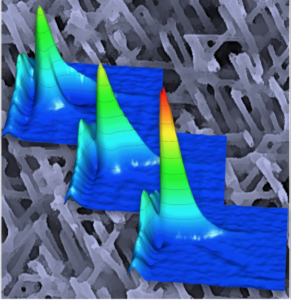Physics Professors Study Magnetism in 3 Dimensional Nanoscale Networks for Next Generation Information Storage
Today’s magnetic devices used for information storage, such as the recording media in hard disk drives, overwhelmingly are based on ultrathin films of magnetic materials that are two-dimensional. Three-dimensional (3D) assemblies of nanoscale magnets offer unique opportunities to explore magnetic phenomena in intriguing and complex configurations, with vast potential to reshape how information is stored and processed.
In a recent paper published online in Nano Letters, Department of Physics professors Kai Liu and Gen Yin along with their team examine 3D nanomagnetism in a novel type of low-density metallic nanowire networks.
They find that the unique network structure, particularly the numerous intersections, modifies how different parts of the network are magnetized, or “addressed”, which could be useful for 3D information storage.
About Their Research

3D nanomagnetism explored in metallic nanowire networks.
The networks are shown in the background with an artist’s view. Their “magnetic fingerprints” (colored plots) capture details of the magnetization reversal and interactions among different segments of the networks. Credit: Edward Burks, Dustin Gilbert, and Kai Liu
The team first created a porous template by exposing a thin membrane to multiple beams of energetic ions directed at certain angles, each ion creating a latent track. Subsequent etching and electrochemical deposition processes led to free-standing, interconnected nanowire networks made of copper and cobalt.
The magnetic properties of the cobalt networks were captured by an elaborate sequence of measurements that were taken at different network orientations, analogous to panoramic dental x-rays.
Interestingly, the “magnetic fingerprints” or signatures of such networks reveal fascinating interactions among different segments and how one particular region may be influenced by an external magnetic field as well as the magnetic states of its neighbors. The numerous intersections are found to play a key role in guiding how the magnetized region propagates.
“It is in principle possible to encode digital information into the magnetic state of the networks, by selectively addressing certain branches, and propagate it through the network for potential 3D magnetic memory and logic devices,” says Liu, senior author of the study and McDevitt Chair in physics.
Such networks of magnetic nanowires may also find applications in brain-inspired neuromorphic computing.
“The networks can host multi-state configurations that are discrete and repeatable, functioning as artificial synapses and neural networks. This may result in novel schemes for next-generation information processing,” says Yin.
This work was a collaboration with the University of California – Davis, University of Tennessee -Knoxville, Sandia National Laboratories, and Lawrence Livermore National Laboratory, led by Edward Burks and Dustin Gilbert. It was partly supported by grants from the National Science Foundation, Defense Threat Reduction Agency, Department of Energy and the nCORE SMART center, sponsored by the Semiconductor Research Corporation and the National Institute of Standards and Technology.
